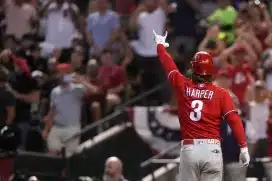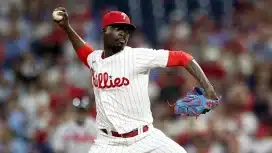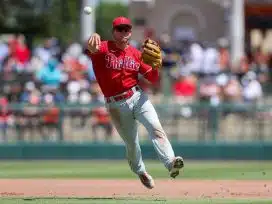By Tim Kelly, Sports Talk Philly editor
When I first began to watch baseball in the late 1990s, there was nothing cool about the Philadelphia Phillies. As a child, I went to a home daycare center run by a family that was from New York. As you can imagine, they were gigantic Yankees fans, during one of the greatest stretches in the team's illustrious history. I distinctly remember consistently being teased during the summer of 2000, when the Yankees were on their way to their third consecutive World Series title, while the Phillies were headed for the worst record in the sport.
The Yankees, at least so far, haven't stopped being cool. But a decade later, there was a brief period where the Phillies may have been the coolest team in the sport.
2000 was the last time (for a while) that the Phillies were embarrassingly bad. They would play six more seasons without reaching the playoffs, but between 2001 and 2006, the team won 511 games. Jimmy Rollins made three All-Star teams. Chase Utley began to establish himself as one of the most dominant second baseman that the sport ever saw. Ryan Howard won the National League Rookie of the Year in 2005 and the National League MVP a season later. And Cole Hamels made his major league debut in 2006, giving Philadelphia hope of having its first ace since Curt Schilling.
By now, you know the story. That core group, along with Carlos Ruiz, Shane Victorino, Jayson Werth and Brad Lidge, would go on to win the 2008 World Series.
It's strange, I thought all of a sudden that would make the Phillies cool. Instead, in a year where the Yankees missed the playoffs for the first time since 1994, the world seemed to largely tune out the playoffs. The Phillies' five-game World Series win over the Tampa Bay Rays became the lowest rated World Series in recorded history.
I showed up at *middle* school on October 28, 2008, expecting the day to be a celebration of the first Phillies title since 1980. Instead, there were maybe 10 people wearing Phillies jerseys, and almost nothing different about the day than any other school day.
That was it. If the world was largely uninterested about the Phillies when they won the World Series, they would never be cool.
Over the next two years, a funny thing happened. The Phillies did become cool.
In my final year of middle school, the Phillies again made the World Series. Cliff Lee and Chase Utley couldn't propel a team that largely went cold in the World Series to their second consecutive title. And yes, they lost the 2009 World Series to the Yankees.
But the Phillies had made the World Series for a second consecutive year. Future Hall of Famer Pedro Martinez joined the team in July, in an attempt to win his second World Series title. Multiple outlets indicated that former Cy Young Award winner Roy Halladay wanted to be traded to the Phillies, if anywhere. That didn't come to fruition before the July 31 non-waiver trade deadline, but the consolation prize was Lee, who was the reigning American League Cy Young Award winner.
Less than two months after Lee became a hero to Phillies fans, Ruben Amaro Jr. traded him to the Seattle Mariners, likely because of fears that the team wouldn't be able to re-sign him after the 2010 season. At the same time they completed a deal to move Lee, Amaro finished a deal to acquire Halladay. Amaro traded one of the three best pitchers in the game away, while acquiring the best pitcher in the sport. Halladay would later tell David Gambacorta of Philadelphia Magazine that he worried that Phillies fans wouldn't like him because he was essentially Lee's replacement.
Suffice to say, he didn't have any problems winning Phillies fans over.
In his first five starts with the Phillies, "Doc" threw two complete games. It was part of the league-high nine complete games that he threw in 2010. One of those nine complete games came on May 29, when Halladay threw a perfect game against the then Florida Marlins. Another one came on Sept. 27, when Halladay threw a two-hit shutout as the Phillies clinched their fourth consecutive National League East title in a win over the Washington Nationals.
Halladay finished the 2010 season with a 21-10 record, a 2.44 ERA and a 6.1 WAR (per FanGraphs). In his first year with the team, he won the National Leaguec Cy Young Award, becoming the fifth pitcher in MLB history to win a Cy Young Award in each league.
History may have forgotten this, but after adding Roy Oswalt to a rotation that already included Halladay and Cole Hamels, the Phillies entered the playoffs as the odds-on favorites to win the World Series. Now in high school and very much associated with my expertise on Philadelphia sports, I remember Oct. 6, 2010 very distinctly. I had a sixth-period study hall that was essentially a free-for-all. Only that day, instead of students causing enough trouble in the study hall to be sent to in-school suspension, many people were wearing Phillies jerseys and talking about their excitement for the team's first playoff game that day against the Cincinnati Reds.
It had happened, less than two years after my dismay at the lack of excitement for the Phillies winning the World Series, there was almost a line of people that wanted to talk about the Phillies with me. It wasn't because I had suddenly become super popular, it was because eastern Pennsylvania had fallen in love with the Phillies. And even people that weren't Phillies fans – ones that would have balked at the suggestion of the Phillies being the most interesting team in the league not long before – couldn't contain their excitement about getting to see the era's best pitcher make his postseason debut.
That moment could have been the end to this story. The Phillies, at least for a day, were cool. But the next day, they were about to be a whole lot cooler.
Halladay's nine complete games during the 2010 regular season propelled him to the Cy Young Award. His one complete game during the postseason propelled him to baseball immortality.
It took Halladay 11 years to reach the playoffs. He only needed to get the ball once to cement himself in the annals of postseason history. The 33-year-old threw just the second no-hitter in the history of MLB postseason in the first playoff start of his career.
As I walked into school the next day, I knew it wasn't going to be just another school day. Instead, it turned out to be a day where even the most unfriendly or sports unaware teacher was happy to talk about Halladay. It had happened – the Phillies were cool. They were even cooler than the Yankees, who had won Game 1 of the ALDS over the Minnesota Twins the night before.
Little did any of us know, the Phillies would be even cooler a few months later when Cliff Lee returned to the team as a free-agent to build a super rotation with Halladay, Hamels and Oswalt. But there's nothing quite like the first time.
Halladay said at his retirement press conference that he wanted to leave the sport of baseball better than he found it. He did that, all while achieving the seemingly impossible task of making the Phillies cool. At 40, he's tragically gone at far too young of an age. But the legacy that he leaves as his era's best (and coolest) pitcher is immortal.







